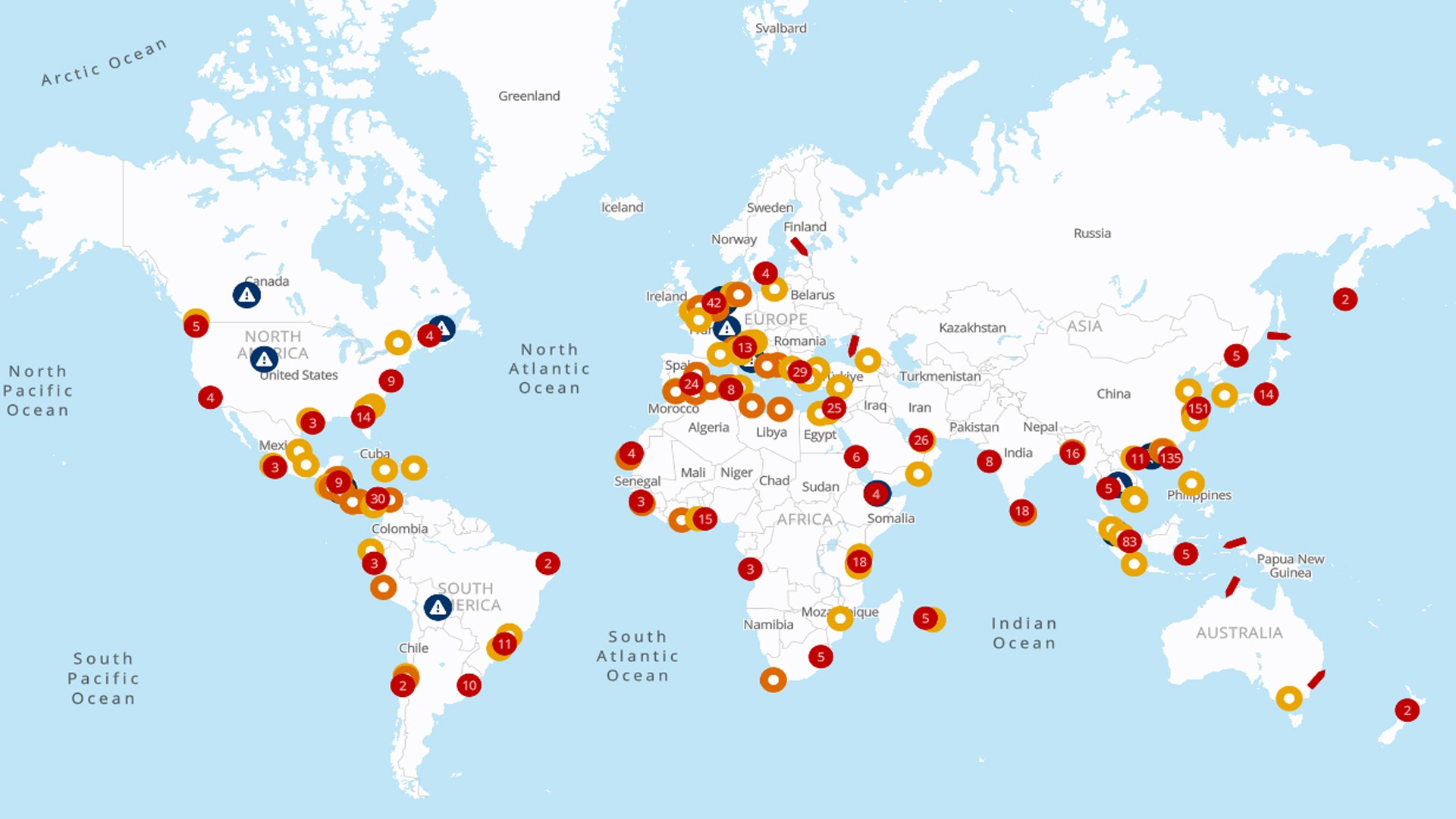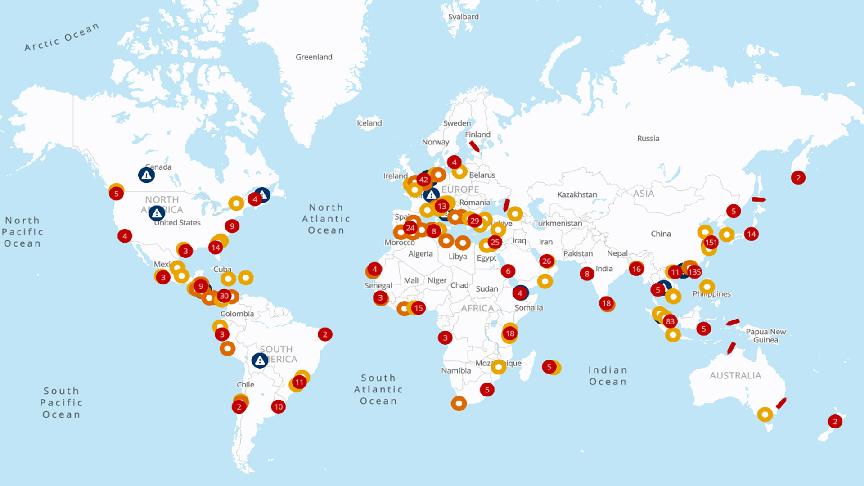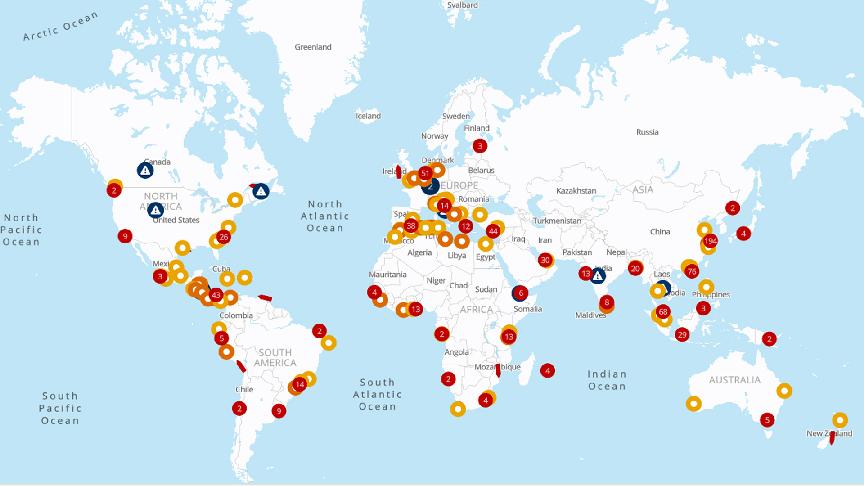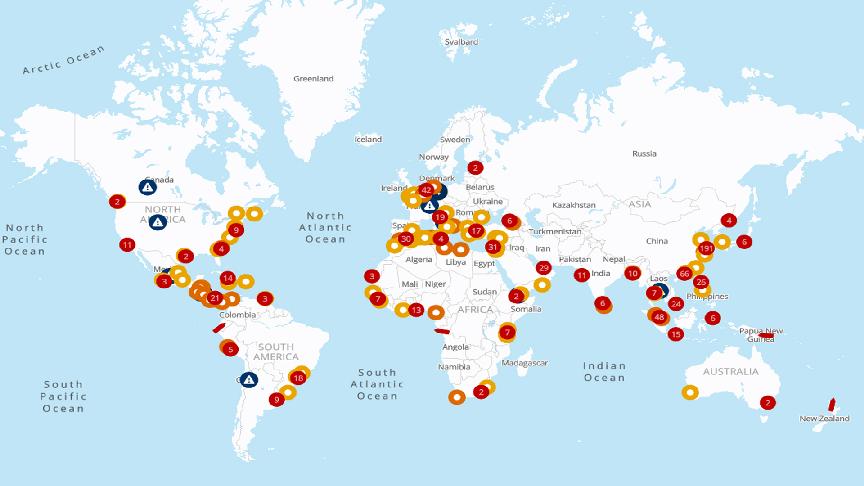- Stay ahead of supply chain disruptions and port congestion with Kuehne+Nagel’s weekly port operational update.
- Find out the latest vessel waiting times and status of ports in Africa, Asia Oceania, Europe, Middle East-Indian Subcontinent, North America, and South and Central America.
Africa
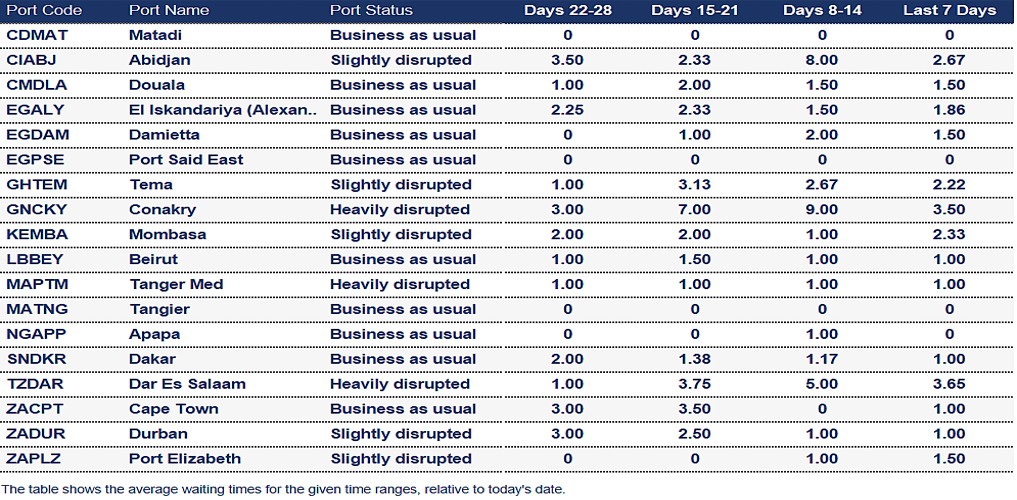
Ghana
Tema: Waiting times have slightly improved in Tema this week. On-window vessels wait on average a day for a berth, while off-window arrivals wait up to 3 days. Six vessels were at anchor at the time of publishing.
Guinea
Conakry: Carriers report huge operational challenges at the port affecting vessel schedules and reliability. Earlier this week, berthing delays were around 7 days. At the time of publishing, two vessels were waiting for a berth.
Ivory Coast
Abidjan: The waiting time has improved this week; however, yard congestion is resulting in lower productivity and berthing delays. Seaexplorer showed three ships at anchor at the time of publishing.
Kenya
Mombasa: Carriers report berthing delays of up to 4 days in Mombasa. Due to vessel space limitations and scheduling, shipments to Mombasa could face additional transhipments and extended transit times.
Mauritius
Port Louis: Although the average vessel waiting time is around 1 day, carriers report port omissions should a vessel arrive outside its berthing window. This is due to the limitations on berthing windows at the port. Should a vessel omit the port, it could result in longer transit times for shipments to Mauritius.
Morocco
Tanger Med: Congestion continues at Tanger Med. At TAT, carriers report waiting times of up to 6 days. The yard is congested due to an increase in discharge volumes from late-arriving vessels.
South Africa
Cape Town: Operations are normal in Cape Town with the exception of incremental weather disruptions. At CTCT, some vessels can wait up to a day for a berth.
Durban: Operations are continuing without challenges. At Pier 1 and Point terminals, vessels can wait up to 2 days for a berth.
Port Elizabeth: The port also faces disruptions due to seasonal strong winds. At NCT, ships can wait up to 2 days for a berth, depending on the service.
Tanzania
Dar es Salaam: This week, waiting times show a slight improvement, and seven vessels are waiting at anchor. The terminal gate and road are congested, resulting in further delays at the port. Due to vessel space limitations and scheduling, shipments to Dar es Salaam could face additional transhipments and extended transit times.
Asia Oceania

- A powerful 8.8-magnitude earthquake struck near Russia’s Kamchatka Peninsula on 30 July 2025, causing significant disruptions along the coasts. The earthquake triggered a series of tsunami warnings and evacuation orders across Japan, the US West Coast, and parts of the Pacific. Read more
China
Ports remain congested in northern China. At the time of publishing, the seaexplorer alert map showed 173 vessels waiting at Shanghai-Ningo anchorage, up from last week's 108.
Tropical Storm Co-May is expected to make landfall on 31 July in East China. The terminals in Shanghai and Ningbo are closed, and waiting times have increased to 3 days at these ports.
Japan
On 30 July, vessel operations were suspended, and the terminal CY gates closed at several Japanese ports due to the earthquake and tsunami warnings. At the time of publishing, Tokyo, Yokohama, Omaezaki, Shimizu, Nagoya, Yokkaichi, and Shibushi remain closed.
Operations resumed in Kobe from 13:00 on 30 July. In Moji, Osaka, Hakata, and Oita, operations have returned to normal. In Naha, gates closed at 13:00 on 30 July.
New Zealand
High winds and rain were expected on Monday and Tuesday across New Zealand. The port of Tauranga reported the suspension of vessel cargo operations and pilotage on 28 July. This has resulted in delays of 18-24 hours for vessels Capitaine Tasman, MSC Nassau, and ANL Rotorua. Arrivals scheduled for the rest of week 31 can expect delays of 12–24 hours, depending on conditions.
Europe
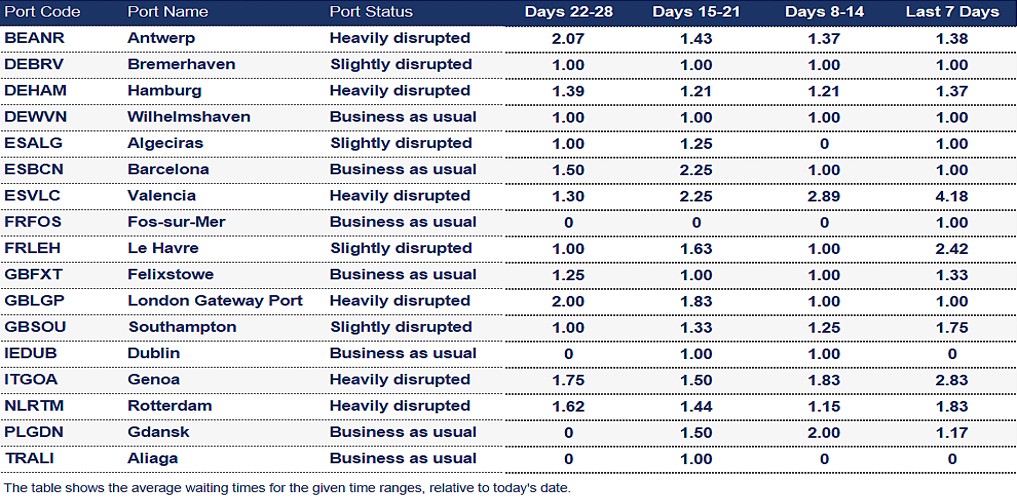
Belgium
Antwerp:
- Q913: Waiting times may increase to 2 days for vessels at this terminal. The yard density remains high, and delivery restrictions remain in place. Truckers are encouraged to use off-peak hours for import pickups. During peak hours, truck turnaround times are around 1 hour. Labour supply over weekends is reduced. Barge delays are currently 48-72 hours.
- MPET: Congestion remains at the berth and in the yard, resulting in longer waiting times for container pickup and delivery. Barge delays are between 12 and 48 hours.
Germany
- As of 1 October 2025, the container release process at the German ports of Hamburg, Bremerhaven, and Wilhelmshaven will undergo a major transformation. The current PIN-based system will be replaced by a fully digital authorisation method known as the "secure release order." This new procedure will eliminate the need for PINs and will be based on a fully digital and closed release and collection process. Read more
- The operational situation at the Port of Hamburg and along the northern rail corridors remains critical. Conditions for train arrivals and departures have not improved. Severe infrastructure congestion has led to a shortage of train parking capacity, resulting in significant backlogs. This disruption is also affecting connections to Bremerhaven, Wilhelmshaven, Rotterdam, and domestic routes within Germany. Terminal processing delays are causing substantial hold-ups for import trains and forcing the cancellation of additional import slots. Consequently, shipment planning is being postponed.
- The complete closure of the A59 motorway in both directions between the Duisburg-Nord and Duisburg interchanges may result in significant truck delays. In the direction of Duisburg, the closure will be from Tuesday, 29 July 2025, 20:00 to Tuesday, 12 August 2025, 05:00. In the direction of Dinslaken, the motorway will be closed from Tuesday, 12 August 2025, 20:00 to Tuesday, 26 August 2025, 05:00.
Hamburg
For all Hamburg terminals, berthing lineups are full and yards are heavily utilised. AT CTB, vessels can wait up to 2 days for a berth. At CTT, off-window calls are subject to waiting time. Export truck delivery restrictions remain in place. Labour shortages are expected until September.
Italy
- Further rail network closures have been announced for August. This time, trains to/from La Spezia-Livorno-Ravenna (via Rivalta, Padua, Marzaglia, Bologna) are affected. For an overview of the rail closures, refer to our Sea News article.
- Maersk began operations at the Port of Milazzo, Sicily, with the maiden call of the Sider London on 17 July 2025. According to Maersk, its vessels will be handled at the Duferco Terminal Mediterraneo (DTM), the first private container and multipurpose terminal in Sicily. The terminal can accommodate standard dry, refrigerated, IMO (excluding classes 1 and 7), and out-of-gauge containers.
Genoa: Some carriers report waiting times of up to 3.5 days, resulting in port omissions to avoid delays. The yard density is around 90%. A shortage of manpower is resulting in vessel operation delays.
Netherlands
Rotterdam
Due to construction, rail restrictions will be in place at the port of Rotterdam from 2-4 August. Trains may not be able to call at individual terminals, and operations may be delayed.
- ECT: The berthing lineup is full, with vessels requiring a high move count. Carriers report 2 days of waiting time for late-arriving vessels. Despite being highly utilised, the yard is manageable. Nevertheless, imports should be picked up as soon as possible and preferably during off-peak hours, due to high waiting times during peak hours. Barge delays are currently 24-48 hours.
- RWG: Heavy congestion and significant delays continue at the RWG terminal. Carriers report average waiting times of 10 days. Yard utilisation remains critical due to high import volumes. Imports should be collected as soon as possible. Barge delays are currently 48-72 hours.
Spain
Algeciras: Carriers report a high yard density of around 85% and a full berthing lineup. Vessels can wait up to 1.5 days. TTIA adopts a dynamic berth model prioritising loading-heavy vessels to maintain terminal flow.
Barcelona: Vessels are usually berthing on arrival, although some can wait up to 36 hours for a berth. At the time of publishing, three vessels were waiting at anchor.
Valencia: Due to vessel bunching, the average waiting time has increased to more than 3 days this week. At the time of publishing, 15 vessels were waiting for a berth. Yard utilisation is high, which can result in delays.
United Kingdom
London Gateway: Due to vessel diversions, waiting times at the port have improved. However, productivity is currently lower due to recent power and system outages. Terminal dredging is ongoing.
Middle East - Indian Subcontinent
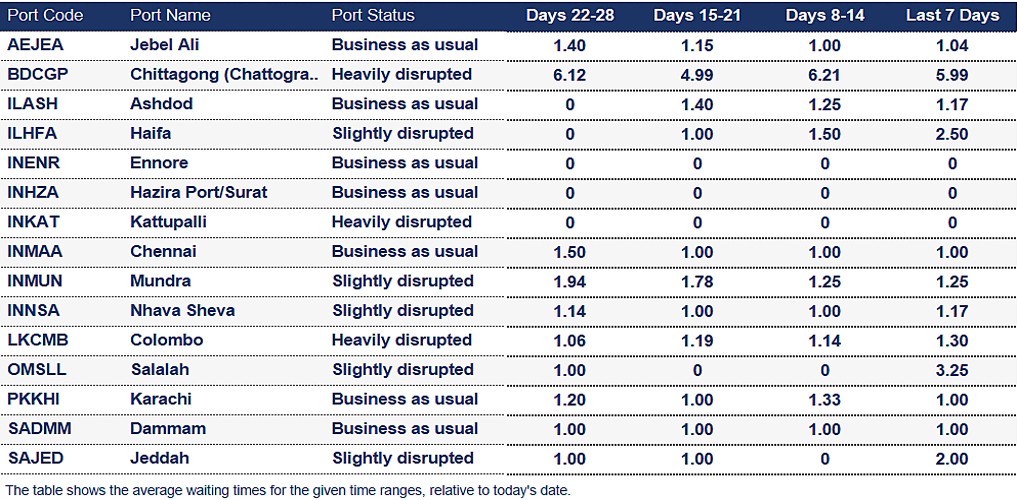
Bangladesh
Chittagong: Berthing delays range between 6 and 8 days, with gearless vessels waiting up to 10 days for a berth. Port stays are 3 to 4 days on average. In addition, yard utilisation remains high, and some areas are waterlogged, impacting productivity. A locomotive shortage is resulting in rail dwell for Dhaka ICD imports of 20-22 days for 20-ft containers and 20-23 days for 40-ft containers. At the time of publishing, 16 vessels were waiting for a berth.
India
In Mundra, Kandla, and Nhava Sheva, monsoon weather intermittently halts port operations, delaying vessels.
Sri Lanka
Colombo: Monsoon weather is impacting port operations at the transhipment hub. The number of vessels waiting at anchor has not improved this week and remains high at 13. High yard density and inter-terminal transfer challenges are also causing delays. Transhipment cargo may be delayed by 1-2 weeks.
North America
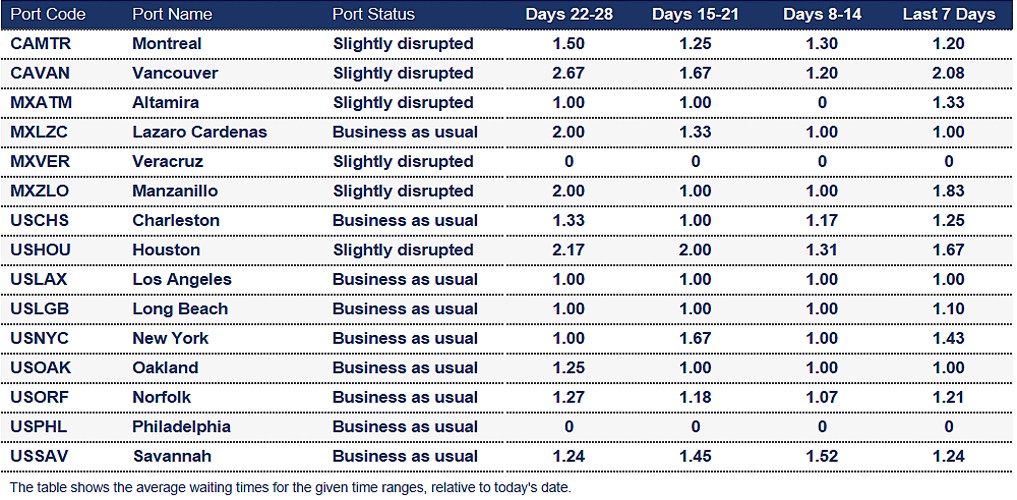
Canada
Due to seasonal low water levels in the St. Lawrence River, shipping operations are facing delays and capacity constraints for cargo to Montreal and Halifax. Forecasts show a downward trend in the water levels for the medium and long term. Read more
Average import rail dwell time for Canadian cargo (Vessel arrival to departure rail ramp):
- Halifax: 4 days
- Montreal: 10 days
- Prince Rupert: 5 days
- Saint John: 6 days
- Vancouver: 7 days
USA
Average import rail dwell and transit time for US cargo (Vessel arrival to departure rail ramp):
- Montreal: 6 days
- Prince Rupert: 3 days
- Vancouver: 5 days
- Charleston: 3 days
- Houston: 6 days
- Los Angeles: 7 days
- Long Beach: 7 days
- New York: 5 days
- Norfolk: 3 days
- Savannah: 1 day
South and Central America
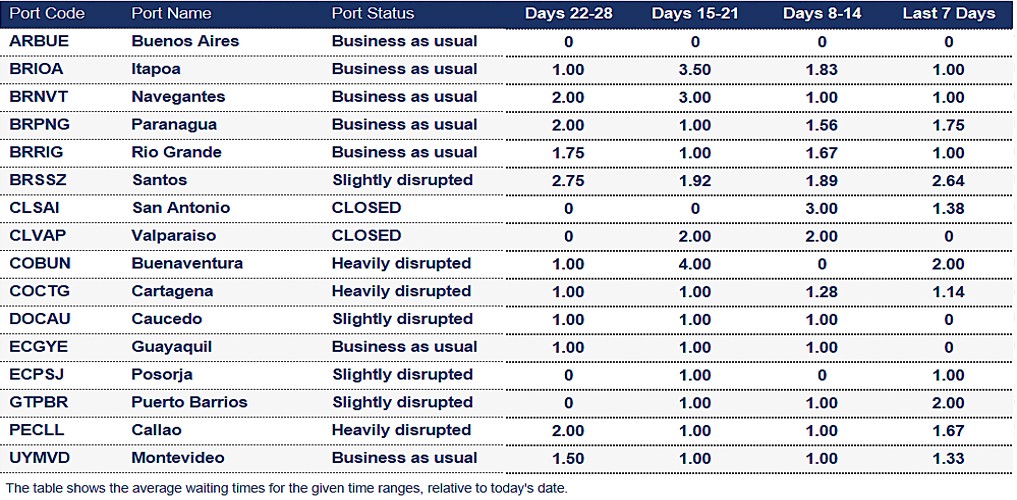
Brazil
Manaus: The water levels of the Amazon River continue to decrease, resulting in navigational and operational complexities in calling Manaus. Capacity limitations and delays can be expected.
Bolivia
The fuel crisis in Bolivia is worsening. Diesel shortages are severely impacting the agriculture and logistics sectors. Truckers are staging blockades in protest, disrupting the movement of goods across the country. Private fuel imports are being allowed to ease the pressure; nevertheless, the situation remains critical.
Chile
Tsunami warnings were raised in Chile on 30 July. And all ports are closed until further notice. Read more
Equipment shortages are affecting operations at Coronel and San Vicente.
Colombia
Although congestion is improving in Cartagena, transhipment volumes remain high. On the other hand, congestion is worsening in Buenaventura. The port is challenged by container backlogs, security concerns, and the forced nationalisation of cargo. Time taken for import release is increasing, and yard utilisation is around 90%.
How Kuehne+Nagel calculates the 7-day average vessel waiting time
Mainline container vessels may spend a certain number of days waiting at designated anchorage areas before their scheduled port call.
To calculate the 7-day average waiting time, we consider the waiting days of these vessels, excluding:
- Waiting times for feeder vessels,
- Idle ships without an announced next port,
- Slow steamers heading toward the anchorage but not actively waiting within the designated area
- Vessels passing through the anchorage area without intending to call at the port.
This rolling average is based on the data from the last seven days and is updated daily in seaexplorer.
To find the latest waiting time for a port, enter the port name or code in the search bar and select the relevant option.
Stay Ahead Stay Informed: Register for seaexplorer for the latest disruptions and vessel waiting times at global container ports.
